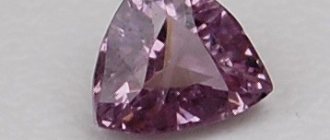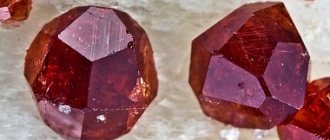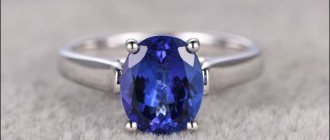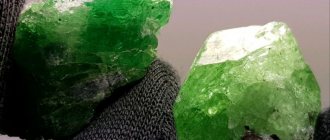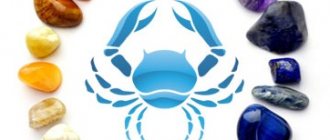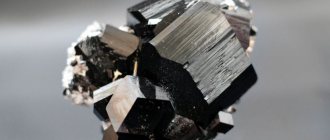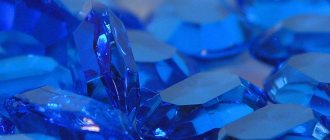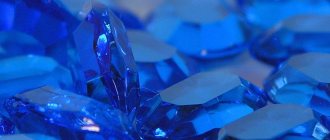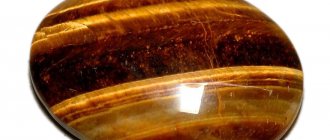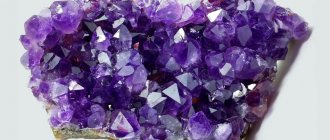History of the discovery of the crocoite stone
German chemistry professor Johann Lehmann received an invitation from the Russian Imperial Academy of Sciences in 1761. Soon he went to the Urals, where, while examining mineral samples from the Berezovsky mine, he discovered a fairly heavy red stone from which lead was easily extracted. Calling it “Siberian red lead,” they found out that it has shades of fiery color, and its crystals are found in the form of small pyramids of irregular shape.
During his research, Lehman produced oil paint of unprecedented brightness from “red lead.” It was a valuable find. They even decided to call the mineral lemanite, but later it was given the name crocosite for its bright color, similar to the color of crocus dye. Then crocosite was renamed crocoite, as a more euphonious name.
Although crocoite, known as lead ore, still did not give rest, because in the third part of crocoite there was still some substance, hitherto unknown. It turned out to be chrome. When the young French chemist Louis-Nicolas Vauquelin decided to study red Siberian lead in more detail, a previously unknown metal was discovered. Its needle-shaped crystalline structure allowed the metal to shine brightly in the light. The metal was called chromium. This is why crocoite has the ability to shine almost as well as an “indestructible” diamond.
Crocoite - its main characteristics
Firstly, it should be noted that crocoite’s chemical composition is red lead ore. It has an amazing crystal shape that looks like spruce needles or elongated prisms. Crocoite can often be seen in the collections of lovers of unusual stones.
The basis of the molecular formula is lead chromate – Pb [CrO4]. Sometimes crocoite contains silver or zinc. Crocoite does not like exposure to direct sunlight; its brightness may decrease somewhat and the stone may fade.
The stone has translucent crystals with a beautiful shine. However, this mineral is quite fragile, with an uneven fracture (hardness - 2.5 - 3.0; density 5.9-6.1 g/cm3), and is highly sensitive to acids and alkalis. It follows from this that jewelry made from this stone must be handled with care.
Crocoite deposits
Crocoite was first discovered in the Urals (Berezovskoe deposit). It is also mined on the island of Tasmania (Australia), Brazil, France, Germany, USA (Arizona, California), and the Philippines. Each deposit has minerals with different colors. Collectors consider Tasmanian Druze to be the most beautiful and expensive. Their crystals reach a length of 15 cm.
Origin story
Red lead ore was first described by M.V. Lomonosov in 1742, when the fundamental work of the Russian scientist was preparing for publication. But the honor of discovering the mineral was given to a citizen of the Russian Empire, mining adviser, deputy in the department of chemistry of M.V. himself. Lomonosov - I.G. Leman. The report made by this scientist on June 9, 1766 laid the foundation for Russian mineral science. At the insistence of Russian academicians, in order to consolidate primacy in the discovery of crocoite, a publication was made already on June 22 of the same year - a brochure was published in the form of a letter to one of the French scientists. This is how scientists defended their right to make a discovery.
Mineral – Crocoite
Interesting! This mineral has received different names. On behalf of the discoverer - lemanite, from the crocus flower - crocosite, as well as others. Only the name crocoite stuck, as the most euphonious.
The stone described by Lehman, flaming in the rocks like frozen fire, was discovered in the Middle Urals. The Berezovsky mine, where the discovery took place, was previously gold-bearing. But the gold mines in it have dried up. The search began, which led the miners to accumulations of the mineral. Now this gem can be found by many. You just need to know that it is found, most often, among quartz deposits.
Do you know? It was the discovery of the mineral crocoite that led to the production and discovery of a new chemical element, until then unknown to any scientist. This element is chromium.
Chemical composition
Lead oxide (PbO) 68.9%, chromium oxide (CrO3) 31.1%.
Crystallographic characteristics
system .
Class. Prismatic - 2/m. Axle ratio. 0.960: 1: 0.919; р = 102°33′. a0 = 7.11 A, b0 = 7.41 A, c0 = 6.81 A, p = 102°33\ Z = 4. Two more polymorphic modifications are known:
Crystal structure
Two more polymorphic modifications of crocoite are known: rhombic - stable in excess SO4 solid solution, and tetrogonal - stable at high temperatures or in the form of displaced MoO4 crystals
Main forms : m{110}, f{120}, t{111}, z{011}, s{441}, c{001}.
Deposits and production
There are many colorful gemstones in the depths of the Earth. But bright crocoite is rare. In the Berezovsky mines, its largest deposits were very quickly developed. This stone was mined in industrial quantities at several other mines, including Preobrazhensky. Large quantities of gems shimmering like living fire were sent abroad. Soon the mineral almost ceased to be found by miners.
Its use as an ore for lead was questioned from the very beginning. But the researchers assumed that with the help of the fire gem it would be possible to launch the production of oil paint for artistic purposes. The mineral, as experience showed, mixed well with oil and gave a wonderful, juicy shade. But the decrease in production of the uniquely bright stone did not allow it to become an ordinary industrial raw material. Now crocoite crystals accumulate in mineralogical collections.
Also read: Quartz Hairy – the frozen curl of Aphrodite
This rare and incredibly beautiful stone is mined in many countries. After the Russians, the mineral was discovered by geologists on the island of Tasmania (Dundas mine). The local crystals are still some of the largest, most beautiful and expensive.
This is interesting! When Russian scientists discovered crocoite, they sent samples of the mineral to academies in other countries. After this, the gem began to be studied and mined on all continents.
In the United States, deposits are known in California and Arizona. The stone was also obtained in the Philippine Islands (Luzon Island), as well as in Brazil (Congonhas do Campo, Goyabeira). Among the European countries that turned out to be rich in gemstones are England, France and Germany.
Form of being in nature
The appearance of crystals . Crocoite crystals are usually prismatic along [001]; also extended in parallel [101]; sometimes octahedral with {111], {111} or, as it were, sharply rhombohedral with {110}, {hol}. The edges are predominantly smooth and sparkling; {110} are usually streaked along [001], and the sharp dihedrals are rounded or jagged. The crystals are often cavernous or hollow, also massive, imperfectly columnar to granular,
Aggregates. Impregnation, dense masses, deposits.
Physical properties
| Property | Description |
| Formula | PbCrO4 |
| Hardness | 2,5 — 4 |
| Density | 5.9 - 6.1 g/cm³ |
| singonia | Monoclinic |
| Kink | Conchoidal, uneven, fragile |
| Cleavage | Clear |
| Shine | Diamond, bold |
| Transparency | Translucent |
| Color | Orange-red |
At first glance, thanks to its diamond shine, crocoite gives the impression of being a fairly strong stone. But it is not at all as durable as it seems. Quite the contrary. It scratches easily. It can be accidentally damaged, broken, split. If a crystal is passed over a hard surface, it leaves a mark, like a pencil lead. That is, they can create a pattern consisting of bright orange lines.
Since the mineral contains lead, its specific gravity is high. Most often, crystals are transparent if they are small in size. As it increases, the transparency of the crystal decreases. Crocoite has the ability to fade in light. Therefore, collectors very carefully select the conditions for its storage.
Important! Lead compounds in the mineral are safe; upon contact, lead does not enter the human body through the skin and lungs, as it remains chemically quite well bound.
Description and external signs
Crocoite is the main source of lead-chromium ore, which may contain a variety of impurities and inclusions. Crystals of fiery orange, red or yellow color can take on an unusual shape, which is commonly called druse.
Druse - fused oblong crystals, tightly soldered to each other at the base, but randomly diverging at the ends. Outwardly, such splices resemble nothing more than an ordinary brush, the structure of the bristles of which is similar to the structure of the druse. The name comes from the German druse, which means “brush”.
A druse whose crystals are directed outward from the center, forming a semicircle, is called a flower
Varieties of mineral
Depending on the percentage of impurities and elements contained in the stone, the color of crocoite and its shine vary significantly. For example, crystals mined in Tasmania contain more chromium. Therefore, their color contains more red shades. In the Middle Urals, the mineral has a saffron tint - fiery orange. The presence of silver, iron, and aluminum impurities in this ore adds shine and transparency to the samples.
The range of gem shades is wide. It may even be amber or yellow. But the rarest and most expensive is reddish, dark, rich in tone.
Crystals grow both small, from a few millimeters, and huge, up to 15 cm, in size. As a rule, these are elongated rectangular prisms with sharp, pyramidal ends. Crystals have the following forms:
- accumulations in the form of drusen;
- accumulations that envelop the surface of underlying rocks with a granular layer or coating;
- inclusions in the form of needles or rods.
Also read: Sheelit - a companion for creative people
What does the stone look like?
A typical crocoite looks fascinating:
- This is a transparent or translucent crystal with a bright, almost diamond-like luster.
- Small specimens are like needles, large ones are like prisms with longitudinal grooves along the edges.
- The base color is yellow-orange. Shades vary from soft orange to crimson with brownish tint through rich orange and deep burgundy.
The dimensions of most joints are up to 3 cm. In the Urals, samples are found twice as long; Tasmanian ones reach 15-40 cm.
Healing properties
Minerals tend to influence humans. Including his health. Crocoite is no exception. It is used to combat female infertility. The mineral is especially good for improving the health of a woman’s reproductive system. Pelvic organs, such as the bladder and lower intestine, can also be treated with stones.
Thanks to its stimulating effect on the emotional sphere, crocoite helps improve the functioning of certain parts of the nervous system. But you can use the mineral for treatment only after consultation with a specialist.
Application of crocoite
Crocoite stone photo
Crocoite is a bright mineral that is mostly red in color.
The fragility and low hardness of this stone led to the fact that crocoite did not find its use in industry.
To a large extent, this is a collectible mineral. It is also widely used by jewelry makers.
To make jewelry, crocoite is pre-treated as a cabochon.
After this, it acquires a smooth polished surface without edges.
They do this as carefully as possible. After all, the stone is fragile and can crumble.
Magic properties
The crocoite stone, splashing with fiery glare of light, is considered in magic to be associated with the awakening of passion and creativity. Therefore, it is recommended for people who lack self-confidence. He gives the attention of the opposite sex to women suffering from loneliness. Men become more confident with it, because the mineral enhances the energy of the Umbilical Chakra, which is responsible for love.
The gem also helps to achieve success in public speaking. For those who wear this stone, communications will be much more effective; the mineral attracts recognition and success. Owners of the gem will feel its support in the development of any talents. It is believed that the most powerful decoration will be a pendant. His influence extends to all areas. Earrings help you become a good actor or speaker. And the ring affects musical perception, hearing and voice. Crocoite gives its owner not only the development of abilities, but also protection and patronage, for example, from envy and unkind tongues.
Where is it used?
The properties of crocoite determined the scope of its application:
- The stone is almost never used by jewelers: cutting destroys it, and the cabochon is also fragile. Therefore, the assortment is scanty - pendants, pendants, brooches, earrings.
- Master stone-cutters create interior products: small plastic pieces, tabletop cutlery, pyramids.
- Ordinary grade raw materials are important as a source of chromium.
The main area of application of crocoite is mineralogical collections.
The crocoite segment can be picked up for years, which is what fans do. Their goal is a complete set of samples from all deposits. Plus a variety of shapes. For example, crocoite in aragonite or druse from Tasmania.
Jewelry with mineral
Due to the low strength of the gem, it is rarely processed by cutting, especially the faceted method. The cabochon is used somewhat more often. But in most cases, they try to use crocoite crystals as a finished product, the way nature created them. They just come up with the appropriate fastening, framing, etc. Jewelry only benefits from this.
Jewelry with Crocoite
Products with gemstones are very expensive. After all, this stone is one of the rarest. In addition, its processing is difficult due to the fragility of the material. Therefore, prices for the most modest jewelry start at $50. The most valuable specimens reach a price of 500-800 dollars. In this case, the framing metal is usually brass. Due to the fragility of the stone, precious metals are not combined with it.
Classification
The color range of crystals is small: in nature you can find samples of yellow, amber, orange, and less often - rich red.
The most common forms of crocoite are druses of various modifications (flower, brush, ball), but single oblong crystals are also known, which are formed by splitting off a particle of stone.
Despite the generally accepted name - crocoite, you can also come across such names as:
- Crocoisitis;
- Red Siberian ore;
- Lemanite;
- Kallochrome;
- Fire flower;
- Earth flower.
How to spot a fake
Crocoite itself cannot be counterfeited. But there are cases when several grains of the mineral can be skillfully glued to quartz crystals and pass this product off as natural ores. Such samples are usually of interest to collectors. Only an experienced person who knows how a crystal can be fixed in nature can distinguish a fake.
Also read: Fluorite - a stone that glows in the dark and under ultraviolet light
In any case, the stone should be bright in color and fragile. It should scratch easily. At the same time, it should shine as much as a diamond.
How to wear and care
The stone is soft, fragile, and fades in the bright sun. You need to take care of it delicately:
- Select a separate, opaque, tightly closed box.
- Avoid falls, impacts, and contact with aggressive media.
- Remove dirt with warm water without detergents.
The properties of crocoite force the owner to use jewelry carefully. They are not worn on the beach or a summer walk in the sun. Remove before washing dishes or doing housework.
Compatibility with names and zodiac signs
(“+++” – the stone fits perfectly, “+” – can be worn, “-” – is strictly contraindicated):
| Zodiac sign | Compatibility |
| Aries | — |
| Taurus | + |
| Twins | + |
| Cancer | + |
| a lion | + |
| Virgo | + |
| Scales | + |
| Scorpion | + |
| Sagittarius | + |
| Capricorn | + |
| Aquarius | + |
| Fish | + |
The mineral crocoite does not show any selectivity with names. But his sensitivity to the signs of the Zodiac is noticed:
- Water element signs - Pisces, Cancer and Scorpio. For them, the stone is most suitable. He supports them and moves them through life, improving their spiritual qualities. The most favorable sign for crocoite is Pisces. They receive recognition and fame from the gem talisman, especially in the oratory field.
- Earth element signs - Virgo, Taurus, Capricorn. The mineral gives them the development of communication skills and determination.
- Air element signs - Libra, Aquarius, Gemini. With the help of crocoite, they improve the emotional sphere and become more balanced.
- Fire element signs - Leo and Sagittarius. They receive honor and respect from the stone, as well as the missing sensitivity and gentleness.
The exception is the sign of Aries. Representatives of this zodiac sign should not wear crocoite. An Aries who possesses this mineral will be prone to pride, arrogance, and vindictiveness.
Is this stone right for you?
Colors and shades
Crocoite has a bright and rich color. The color palette of this mineral is represented by orange-red and yellow-red tones. Samples of rich burgundy color are very rare. It is important that under prolonged exposure to direct sunlight, the stone loses its natural brightness and becomes pale and inconspicuous.
Crocoite in jewelry
The gem is fragile, so it is not suitable for facet cutting. Jewelers, due to the low hardness of the samples, process stones in the form of cabochons or use small crystals of the original shape. Carefully polished crocoite looks amazing!
Jewelry (crocoite jewelry) in the Art Nouveau style with natural orange stones is chosen by romantic intellectuals and creative people.
Pendants are especially popular among women . Bright crocoite enhances the sexual energy of the hostess.
Rings with a rare gem help to reveal the musical abilities of the owner.
Earrings help realize acting abilities.
Amulets with crocoite are given to people of creative professions.
Interesting Facts
- It is believed that crocoite forms a positive attitude towards reality in a person. Its color serves as a symbol of joy, optimism, faith in life and hope for the best.
- Not long ago, the opinion spread that due to its lead content, crocoite can be dangerous for the human body, especially when constantly wearing jewelry made from it on the body. However, such fears have not been confirmed by scientists and today there is no reliable information about the dangers of crocoite.
Price range
Crocoite is far from a cheap pleasure; it’s all about its fragile design. Just one brush 2.5 by 4 by 5 cm will cost about five thousand rubles. Moreover, it will consist of 30% crystals, and the rest is parent rock. If you want longer and larger crystals, which will occupy one second of the product, you will have to pay eight thousand rubles or more. As mentioned earlier, the mineral is fragile, because of this there are a very small number of jewelers ready to work with it, and therefore the number of products is very limited, which makes them very expensive. Even a piece of jewelry with a raw stone measuring 4 by 5 cm will cost three and a half to five thousand rubles. In addition, crocoite has a short service life, so it will soon lose its original color and diamond shine.
Links[edit]
- "Crocoite (PbCrO4)" (PDF). Rruff.geo.arizona.edu
. Retrieved December 19, 2016. - "Crocoite: Crocoite Mineral Information and Data". mindat.org
. 2016-12-15. Retrieved December 19, 2016. - "Crocoite Mineral Data". Webmineral.com
. Retrieved December 19, 2016. - Jump up
↑ Lehmann, J. G. (1766). De Nova Minerae Plumbi Specie Crystallina Rubra (in Latin). Retrieved November 9, 2022. - François-Sulpice Beudant (1832). Traite elementaire de Mineralogie. 2. ed. Verdier. item 669.
- Moore, Thomas P.; Wilson, Wendell E. "Major Discoveries of Crocoites" (PDF). Mineralogical record
.
43
: 651–673. - [1]
- For $300,000 you can own a mine in a Tasmanian ghost town, Damian McIntyre, ABC News Online, April 26, 2019.
- This article incorporates text from a publication now in the public domain: Chisholm, Hugh, ed. (1911). "Crocoite". Encyclopedia Britannica
.
7
(11th ed.). Cambridge University Press. paragraph 479. - Bushmakin A.F., 1996. Crocoite from the Berezovsky gold mines. World of Stones, 10, 28-31
- Bottrill, R.S., Williams, P., Daunt, S., Sorrell, S. and Kemp, N.R. (2006). Crocoite and associated minerals from Dundas and elsewhere in Tasmania. Australian Journal of Mineralogy. 12, 59-90
